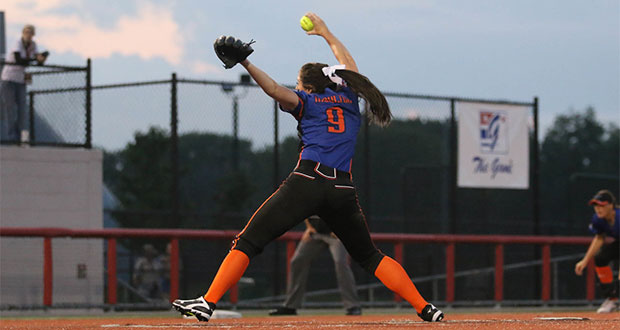Pitching Pointers: The Benefits of Distance Pitching

Distance Pitching Benefits softball pitchers at all levels.
10U Pitching Distance: 35 feet
12U Pitching Distance: 40 feet
14U-18U Pitching Distance: 43 feet
College and Professional Distance: 43 feet
One of the most challenging adjustments pitchers face in their development process is the change in pitching distance as they move up in age groups. Arguably the most challenging and frustrating jump is from 10U pitching at 35 feet to 12U’s looming 40 feet. It is the biggest jump distance wise going from age group to age group and as if that wasn’t hard enough, let’s increase ball size on them too. The 10U group plays with an 11” size softball while all of the other age groups use a 12”. Often times that first year of 12U is a tough one due to the five feet further back and the bigger ball. Sometimes it takes a year for the hand and fingers to adjust and grow, to be able to hold the ball comfortably again like they were used to.
One pitching drill that can aid pitchers who struggle with the distance change is distance pitching or pitching from an even further distance than the new distance. See the list below for the (distance pitching) drill distances, based on the age group of the pitchers.
10U Pitching Distance Drill: 40 feet
12U Pitching Distance Drill: 45 feet
14U-18U Pitching Distance Drill: 47 feet
College and Professional Distance Drill: 47 feet
Once you get the new distance ready, here’s how the drill works and the benefits. Have the pitcher throw five to ten fastballs at the new distance. Before they begin, remind them that they are expected to throw a strike from this new distance. No rainbows allowed! Anyone can hold onto the release and get the pitch to the catcher using an arc. We don’t want that. Would they be able to make it there if they gave the same amount of effort from the beginning distance? Most likely not. Demand more effort. They are going to need three things in order to do what you have asked. They will need more arm speed, more leg push/drive off the mound, and a stronger finish – hard to the front leg and continuing forward even after the pitch has been released. Make them continue forward by taking a few steps towards the catcher to receive the ball. This will ensure that all of the momentum was distributed forward into their pitch.
After they have thrown their five to ten from the further distance, move them back to their original distance and throw five pitches. It’s going to seem CLOSE (which is the point). Before they throw, remind them of the three steps they just took in the distance drill and ask them to apply them to these five pitches. Have them try to picture the catcher further away or tell them to try to throw it through them or try to knock mom/dad off the bucket – kids love that one!
If the pitcher applies the three steps from the distance pitching to the original distance, these five pitches are going to be produced with more speed and look harder. That’s also the point. Once the five original pitches are completed, have them go through one more time, starting with five to ten from the drill distance and then ending with five from normal. This drill is designed to teach pitchers that they always have a little extra to give, and they discover this concept the second they throw a line drive strike from the further distance. The drill increases the speed of the arm, strengthens the arm, uses a little more from the legs, and momentum is used throughout the whole pitch. It also gives pitchers CONFIDENCE! Those who had doubts about themselves because of the change in the distance moving up an age group will no longer have these doubts.
They may not be the best at this drill the first time they do it, and that’s perfectly okay. It’s a tough drill that takes focus and like anything else takes practice. This drill can be completed at the beginning of a pitching workout, or at the end if you want it to serve as a “finisher”. A finisher in pitching is a drill that is completed at the end of the workout when the pitcher is tired. It’s typically something that has to do with strength or conditioning. Pitchers are tired at the end of pitching practices and making things a little harder is how we get better. But that’s a post for another day. Now get out there, increase those distances, and knock those parent catchers off their buckets so we can get some real catchers back there!





